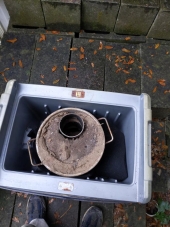




 2
2




 3
3




Walt Chase wrote:They make, or at least used to make, a sort of flare looking thing that could be tossed into a woodstove or fireplace to put out chimney fires. Something like this should work in a RMH. If you use a fire extinguisher make sure you use it in very short bursts so as to not blow embers out into the room.
'Theoretically this level of creeping Orwellian dynamics should ramp up our awareness, but what happens instead is that each alert becomes less and less effective because we're incredibly stupid.' - Jerry Holkins

 6
6




For all your Montana Masonry Heater parts (also known as) Rocket Mass heater parts.
Visit me at
dragontechrmh.com Once you go brick you will never go back!
 1
1




 3
3








 1
1




For all your Montana Masonry Heater parts (also known as) Rocket Mass heater parts.
Visit me at
dragontechrmh.com Once you go brick you will never go back!
 4
4




thomas rubino wrote:Ceramic blanket could be glued to the steel plate to make a seal.
Buckets of sand sound nice, but if space is that limited then where do you store dry unfrozen sand?
I'm really not understanding, exactly what emergency would require rapid shut down.
Do you have any scenarios your thinking of?
The flame is the least hot part of the whole system, the rest simply will not cool down rapidly.
'Theoretically this level of creeping Orwellian dynamics should ramp up our awareness, but what happens instead is that each alert becomes less and less effective because we're incredibly stupid.' - Jerry Holkins




 2
2




For all your Montana Masonry Heater parts (also known as) Rocket Mass heater parts.
Visit me at
dragontechrmh.com Once you go brick you will never go back!
 5
5




regards, Peter
 1
1




Peter van den Berg wrote:There's an old recipe which was used in former days in the Netherlands. Somewhere beside the cole stove a two pounds paper bag of salt was placed on the floor. It could stay there for years until a chimney fire occured. The recipe was to rip open the paper bag and throw it in the fire, bag and all. Immediatly after that all the air inlets should be closed and the chimney fire went out just like that. Presumably the salt getting hot, was producing a gas that's supplanting the oxygen in the stove and the chimney. The stove shouldn't be opened immediatly after the fire was out, the fire could start again in a flash.
Maybe it would work in a J-tube rocket as well?
 1
1





| I agree. Here's the link: http://stoves2.com |




